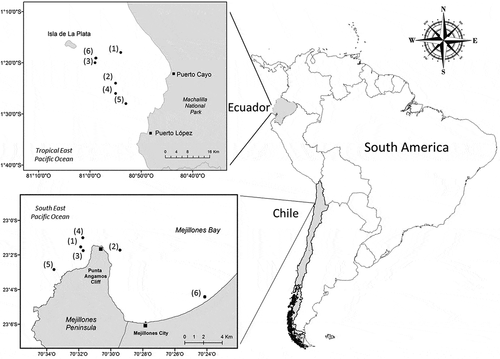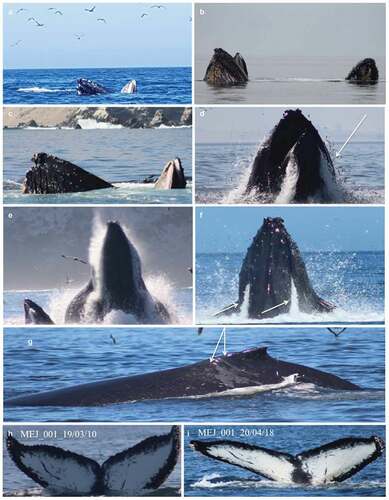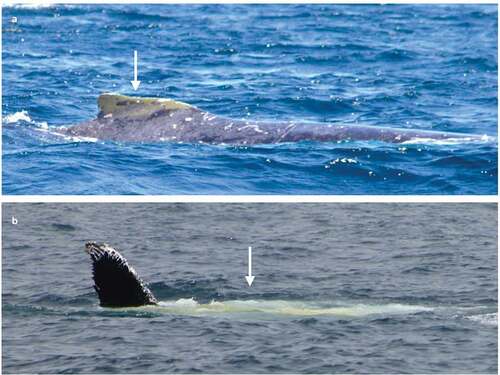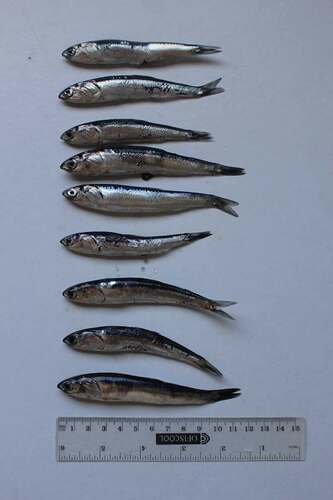Figures & data
Figure 1. Map of Machalilla National Park in Ecuador and Mejillones Península in northern Chile showing the geographic positions (black dots) of humpback whales performing feeding behavior or defecation. Dates of observations in Ecuador: (1) 21 June 2005 (2) 11 July 2008 (3) 13 August 2008 (4) 15 July 2011 (5) 10 August 2016 (6) 13 August 2017. Dates of observations in Chile: (1) 10 March 2019 (2) 12 March 2019 (3) 16 March 2019 (4) 17 March 2019 (5) 23 March 2019 (6) 18 April 2020

Figure 2. Lunge feeding and trap feeding behaviors by two photo-identified humpback whales as documented off the Mejillones Peninsula, northern Chile. (A) One of the whales observed trap feeding during first day of observation (10 March 2019) with mouth kept open for longer than 4 seconds. Peruvian anchovy at the surface were herded towards its mouth with pectoral fins. (B) The same two humpback whales observed on a second day (12 March 2019) performing trap feeding behavior on schools of Peruvian anchovy. The whales remained in parallel position at the surface with mouths wide agape. (C) Trap feeding by the same two individuals recorded on a third day (16 March 2019). (D) Lunge feeding performed by the same two whales on 17 March 2019. Note anchovies (white arrow) escaping from one whale’s mouth. (E) Lunge feeding observed off Mejillones Peninsula on 17 March 2019. Whales emerged in synchrony, one exposing one third of body while the other engaged in lateral lunge feeding. Seabirds fed on anchovies herded to the surface. (F) Lunge feeding documented for the last time (23 March 2019). White arrows indicate how the whale forcefully expels water through the baleen by closing its mouth. (G) Propeller scars of the bigger humpback whale encountered off Mejillones Peninsula. Note abundant grey gulls hovering above the whale. (H) The individual performing lunge and trap feeding in March 2019 was (I) recaptured and seen lunge feeding in April 2020

Figure 3. (A) Humpback whale lunge feeding in protected coastal waters (01°18S,80°54’W) of Machalilla National Park, Ecuador. (B) Slow-moving whale, tilted 90º on its right side, opens mouth and starts lunge feeding. (C) Whale surfacing with wide open jaws and expanded throat pleats; closing jaws after a few seconds. (D) Flukes photo-ID of feeding humpback whales EC666 and EC667 on 21 June 2005 (Photos: C. Castro – PWF)

Figure 4. Evidence of humpback whale defecation at Machalilla National Park, Ecuador: (A) Whale EC1373 at 01°24’S,80°55’W on 11/07/2008 with olive yellow faeces momentarily sticking to dorsal fin. (B) Humpback whale sighted at 01°28’S,80°53’W on 10/08/2016 when suddenly releasing a cloud of faeces of the same olive yellow color (Photos: C. Castro – PWF)


